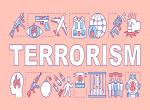The year 2020 shall be recorded as an unprecedented year in the modern history of humankind. The outbreak of China-origin Coronavirus (also known as COVID-19) has eclipsed the events in global security. On one side, the spread of coronavirus enforced nation-wide lockdown and gave a jolt to the economic and political activities in many countries. On the other side, the year also continued to witness terrorist incidents, linked directly or indirectly to several events worldwide. Categorised in two sections: i) National, and ii) International; the year-end review attempts to provide an overview of various factors and events of 2020 and projections at global terrorism theatre in 2021.
National
On 05 August 2019, India made a historic move with an abrogation of Article 370 in the Union Territory of Jammu and Kashmir (post-August 2019). Remarkably, on the first anniversary of the abrogation of Article 370, no protests or major terrorist attack took place in the State as was expected.

In 2020, around 415 terrorism-related incidents were recorded, out of which 139 incidents were of gun-battle between security forces and terrorists. As per the data shown in Table 1, there were fewer fatalities in security forces and a rise in the counts of terrorists killed thus highlighting the successful and synchronised counter-terrorism efforts of armed forces and intelligence fraternity.
In February 2020, a grenade attack on security forces at Lal Chowk of Srinagar was claimed by newly formed terror group—The Resistance Force (TRF). According to intelligence agencies, the TRF group is an off-shoot of “shadowy front” of Lashkar-e-Taiba (LeT) created by Pakistan’s Inter-Services Intelligence (ISI) in response to abrogation of Article 370 in J&K.
In the past few years, the government’s proactive approach to Left-Wing Extremism (LWE), also known as Naxalism, has paid-off well with some positive developments in 2020.

Synchronised counter-LWE operations and mounting pressure by security forces gave a blow to Maoists' leadership at several levels. As a result, in 2020, the total number of LWE incidents in the Maoist-affected States was 556 compared to 673 incidents in 2019.1 As shown in Table 2, in 138 incidents of Maoist-led attacks in 2020, around 134 Maoists were eliminated, whereas 352 others have surrendered and joined the rehabilitation programmes. Maoists, who surrendered, claimed that the years of continued violence gave them a “reality check” of weak and hollow ideologies of Naxalism; and they were disappointed with the exploitation of local tribes by the senior leaders of the Maoist cadre.
With the significant loss of physical territory in Syria and Iraq, the Islamic State (IS) terrorist organisation made efforts to expand towards the Sahel region in Africa and Afghanistan in South Asia. Although the minuscule number of Indian Muslims joined IS as foreign terrorist fighters (FTFs), India remained vigilant to the challenges of radicalisation and Islamic extremism. According to the data compiled based on news sources, in 2020, the law-enforcement agencies, mainly the National Investigation Agency (NIA) arrested around 20 IS sympathisers or operatives, as compared to 34 arrested in 2019.2 In several synchronised intelligence-based operations and raids, the NIA cracked modules or sleeper cells of IS in India. Despite successful crackdowns and no major IS-inspired attack in India, the terrorist organisation is making efforts to grab the attention of Indian Muslims on various religious and political issues, such as Ayodhya Mandir verdict. In its English-language publication—Voice of Hind (Sawt al-Hind), Abu Hamza al-Kashmiri (nom de guerre)—the leader of the IS’s branch focusing on India—Wilayah -e-Hind, exhorted the supporters to remain patient as “victory comes with patience, and use petrol bombs and knives to attack the unbelievers”.3
International
In 2020, several events took place which painted a new canvas of international security and global terrorism. The first week of 2020 began with the assassination of Iran’s Islamic Revolutionary Guard Corps-Quds Force (IRGC-QF)’s Commander Maj. Gen. Qasem Soleimani. Nicknamed as “The Shadow Commander” by the West, Maj. Gen. Soleimani was killed in a targeted US drone strike in Baghdad (Iraq) on 03 January 2020, said to have been approved by the US President—Donald Trump. The killing of Maj. Gen. Soleimani raised questions, including if he was an imminent threat to the US or other allies? Allegedly, the drone strike was not authorised by the US Congress and had no approval from the Iraqi government to use the Iraqi airspace to assassinate a key Iranian military official on Iraqi soil.
On the other hand, a terrorist organisation—Islamic State (hereafter IS) welcomed the killing of Maj. Gen. Soleimani as “divine intervention and a ‘helping hand’ to jihadists”.4
On 29 February 2020, the United States and Taliban signed a historic peace agreement—Agreement for Bringing Peace to Afghanistan, in Doha (Qatar). As per one of the clauses of the agreement, the US may commence the withdrawal of its forces and NATO troops from Afghanistan if the Taliban keeps its commitment to preventing al-Qaeda from operating from Taliban controlled areas. On the contrary, Afghanistan witnessed a steep rise in terrorist attacks allegedly coordinated by Taliban post-US-Taliban peace deal. According to a data, within 45 days of the agreement, i.e. 01 March-15 April 2020, more than 4,500 attacks were reported against security forces5, which is more than 70 per cent compared to the data during the same period the previous year.
With the US forces’ steady withdrawal from the parts of West Asia and parts of North Africa, both al-Qaeda and IS jumped into the competition to prove their respective mettle, especially in West Africa’s Sahel region. With the defeat and loss of physical territories in Syria and Iraq, IS expanded its focus and engaged in fierce clashes with al-Qaeda and its affiliated groups in Mali and Burkina Faso. The year 2020 witnessed the shift of most terrorist activities from West Asia to Africa continent where Jihadist groups—Ansaroul Islam (AI), Boko Haram, Islamic State in the Greater Sahara (ISGS), and Jamaat Nusrat al-Islam wal-Muslimin (JNIM), continues to terrorist attacks and kidnappings. Boko Haram (affiliated to IS) and al-Shabaab (affiliated to al-Qaeda), both groups remained in the news for various terrorist activities, including the December 2020 abduction of 330 school students in North Nigeria claimed by Boko Haram.
In 2020, the coronavirus outbreak may have slowed down the operational capacity of IS. However, the group has been active in the cyber milieu with regular fortnightly newsletters (al-Naba), and other statements from its media outlets, especially the Amaq Agency. Despite the territorial loss, Islamic State is continuing to manage the cyber-infrastructure through its decentralised “virtual caliphate”.
Prognosis for 2021
In 2019 and 2020, the elimination of key commanders— Riyaz Naikoo and Zakir Musa of Hizb ul-Mujahideen (HM) and al-Qaeda affiliated Ansar Ghazwat ul-Hind (AGuH), respectively, has highlighted unmatched and successful synchronisation between intelligence and security forces in Jammu & Kashmir (J&K). However, two newly formed terror factions—The Resistance Force (TRF) and People’s Anti-Fascist Front (PAFF)- would remain a challenge and threat to security in 2021. The creation of terror groups like TRF and PAFF is nothing but a diversion engineered by Pakistan to ease the pressure from Financial Action Task Force (FATF) and avoiding its listing from “grey-list” to “black-list” for supporting terrorist groups. Recently, in January 2021, Pakistan’s Anti-Terrorism Court (ATC) has sentenced LeT chief Hafiz Saeed and operation commander Zaki ur-Rehman to 15 years imprisonment each in terror-financing related cases. However, looking at the history of Pakistan’s action against these terror groups and the timing of sentencing, the action seems to be more of a drama ahead of FATF’s meeting scheduled in February 2021.
The year 2020 witnessed an overall declining trend in LWE-led violence; however, the Maoists groups made every effort to retain the significant operational capabilities in their areas of dominance. In 2021, the Maoist activities may slow down but may nevertheless remain as a challenge for security forces.
In 2021, Islamic State and al-Qaeda, through its affiliate groups or branches in India, may continue to utilise the cyber space to further expand their respective propaganda and radicalisation with incriminating material posted online. Inadequate cyber awareness and required counter-narrative may pose a challenge in countering online radicalisation and extremism.
In recent years, both al-Qaeda and IS have suffered a significant loss in their senior leaderships in 2011 and 2019. Given the political destabilisation and support from indigenous Islamic extremist groups, al-Qaeda and IS would attempt to reassert their legacies through attacks, recruitment, and territorial expansion, if possible, in the Middle-East and North Africa (MENA) region. For al-Qaeda, the ageing factor and health issues of its leader Ayman al-Zawahiri would be one of the major concerns in 2021. In 2021, al-Qaeda and IS may accelerate their operations in Africa, mainly when the national governments and their resources are being utilised for other vital requirements, such as public health amid coronavirus waves in the region. Notably, terrorists of Boko Haram and al-Shabaab tend to switch their allegiance between al-Qaeda and Islamic State depending upon their individual interests. Therefore, it would be only a matter of time to see small indigenous terror groups join the ‘tug of war’ between al-Qaeda and Islamic State, expanding their networks in 2021.
The newly elected Biden-led administration may consider a review of US-Taliban peace deal signed by outgoing President Donald Trump; which agrees on completed withdrawal of the US forces from Afghanistan by the end of this year. The rise in Taliban-led attacks on security forces may give jerks to the peace deal. However, if the deal is implemented successfully, it would bring the Taliban into a significant role in Afghanistan’s politics. India’s investments in the future of stable Afghanistan have been possible because of the presence of US forces on the ground. The US forces withdrawal from Afghanistan would leave a vacuum to be filled up by Taliban and Haqqani Network (HQN) which further pose a considerable threat to India’s interests in the nation.
The year 2021 may also witness the increased use and reliance on emerging technologies, such as drones, Dark Web, and UAVs for reconnaissance purposes. In 2020, State actors—Azerbaijan and Iran- have demonstrated their combat drones' capabilities in the Nagorno-Karabakh conflict and 2020 Riyadh drones attack (Saudi Arabia), respectively. Islamic State has been using drones/UAVs for videography and reconnaissance purposes; however, soon IS and other terrorist organisations may acquire confidence and skills to use combat drones as a force multiplier in asymmetric conflicts attacks.
Endnotes
- LWE: Total incidents 2020, South Asia Terrorism Portal, Available from: https://satp.org/datasheet-terrorist-attack/incidents-data/india-maoistinsurgency, accessed on 07th January 2021.
- Data on total arrests of IS operatives in 2020, South Asia Terrorism Portal, Available from: https://satp.org/terrorist-groups/arrest/india-islamistotherconflicts_islamic-state-or-islamic-state-of-iraq-and-levant-or-islamic-state-of-iraq-and-syriadaish-isis , accessed on 08th January 2021.
- Sawt al-Hind (Voice of Hind), Telegram channel.
- Bowen, Jeremy. “Qasem Soleimani: Why his killing is good news for IS jihadists”, BBC News, 10 January 2020, Available from: https://www.bbc.com/news/world-middle-east-51021861, accessed on 09 January 2021.
- Shalizi, Hamid, Abdul Qadir Sediqi, Rupam Jain. “Taliban step up attacks on Afghan forces since signing U.S. deal: data”, Reuters, 01 May 2020, Available from: https://www.reuters.com/article/us-health-coronavirus-afghanistan-taliba/taliban-step-up-attacks-on-afghan-forces-since-signing-u-s-deal-data-idUSKBN22D5S7, accessed on 06th January 2021.
(The paper is the author’s individual scholastic articulation. The author certifies that the article/paper is original in content, unpublished and it has not been submitted for publication/web upload elsewhere, and that the facts and figures quoted are duly referenced, as needed, and are believed to be correct). (The paper does not necessarily represent the organisational stance... More >>
Image Source: https://st2.depositphotos.com/1152339/11560/i/950/depositphotos_115608612-stock-photo-security-concept-international-security-on.jpg











Post new comment